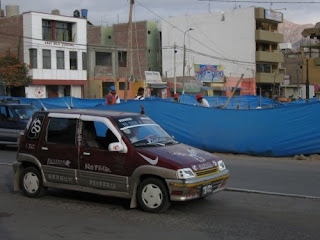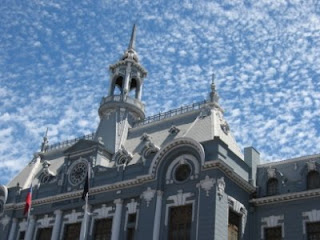Nasca, Peru.













Kara says:
Nasca. A town of about 50,000 in the middle of the desert and finally, this really feels like a different continent - narrow, dusty streets, lots of tiny shops and street stalls, you can buy a chicken that looks like it was alive very recently and there's a butcher in the market hacking up some meat while both he and then meat are covered in flies.
It's a great little town, lively and sleepy at the same time. Nothing much to do but sit in the plaza and watch the world go by but there's enough world going by to make it interesting.
All the cars here (well, at least 2/3) are those tiny little square daewoos (like Martina's old subaru) with one litre engines, the town's full of 'em. Although from the photos you can see that's no obstacle to not needing a bridge over the river. All the taxis (and you know how to pick a safe taxi - they're the ones with the first aid kits stuck up on the inside of the windows so when they maim you at least they can give you a band aid) are little square daewoos and the boy racers have suped up little square daewoos with go faster stripes, lights and the occasional alloy but mainly with as many stickers as they can get their hands on - see photographic evidence. They cruise up and down the main street like in Surfers Paradise and all the cars have a big windscreen sticker with a name (of the driver/car/girlfriend???) or just something like "Dios es Amor".
The reason we came to Nasca was to see some lines in the desert. In the 30s pilots starting noticing hundreds of long, straight lines all over the desert and some drawings of animals. The locals, who had always been aware of the lines, weren't so enthusiastic and no one bothered much about them 'til a (crazy) german mathematician took an interest in the 50s and spent the next 50 years studying the lines, educating the locals and encouraging them to be proud of their culture, to preserve the lines (aparently there was a face-off with farmers wanting to cultivate those areas of the desert) and to use them to attract tourists to the area. The local businessmen loved this woman and now are very proud of their developing tourism industry.
We went for flight over the desert - you can play find-the-drawings with the photos. Karl did his "I'm a pilot you know" routine and got to sit up the front and be in charge of undercarriage and flaps. And no-one died. The lines/drawings were made by removing the top layer of earth revealing a different colour underneath and date from a few hundred years BC to about 700AD. Why? The burning question. The crazy German mathematician thought a astronomical calender. The locals think something to do with placating the gods and hoping for water (still a major issue for a town that gets 2 cm of rain a year) but whatever, they are really really impressive. And of course the real origin of the lines is those darn aliens again.
Other photos are Gaucho Karl goes to town and Gaucho Karl in front of our favourite (and possibly the only) pub. And some "trophy heads" from the museum - with a carry strap for convenience.



Comments
Post a Comment